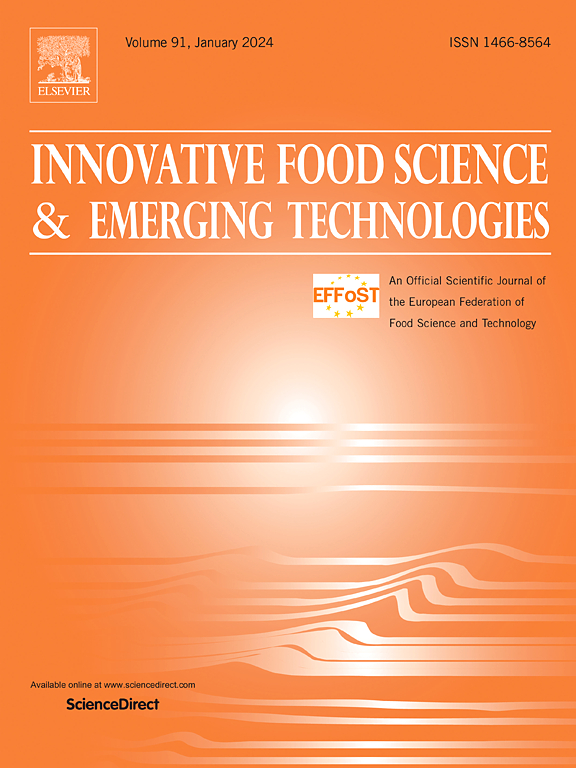太阳晒干无花果品质:超声波、欧姆焯水和二氧化硫预处理对生物活性保留、抗氧化活性和物理性质的比较研究
IF 6.3
1区 农林科学
Q1 FOOD SCIENCE & TECHNOLOGY
Innovative Food Science & Emerging Technologies
Pub Date : 2025-07-01
DOI:10.1016/j.ifset.2025.104105
引用次数: 0
摘要
本研究评价了超声波处理(US)、欧姆漂白(OH)和二氧化硫(SO₂)预处理对太阳晒干伊兹密尔无花果的影响。新鲜无花果在太阳晒干前经受US(10或15分钟)、OH(30或90秒)或SO 2处理。结果表明,在US-10 min时,尽管出现了明显的收缩(69.81%)和变暗(L* = 51.98±2.65),但复水率最高(3.40±0.27)。OH-90 s提高了黄酮保留率,但增加了收缩率(63.52±2.17%),最低亮度值(50.35±2.61)。so2预处理后保持优越色泽(最高L* = 61.10±1.88;最低ΔE = 29.34±1.40)和保存的抗氧化活性,但显示褐变与未处理的对照组相当。US-15 min保留抗坏血酸效果最佳,而OH-30 s和SO 2处理导致抗坏血酸损失显著。感官评价显示,经过二氧化硫处理的无花果总体接受度最高(4.15),而经过US-10分钟处理的无花果感官质量平衡(3.29),风味评分良好(4.0)。研究结果表明,US-10分钟是一种很有前途的非热替代方法,可以平衡干燥效率和质量,而so2在视觉上具有吸引力,但需要优化褐变控制。这项研究为干无花果生产提供了实用的见解,突出了物理特性,营养价值和视觉质量之间的权衡。本研究解决了无花果加工业面临的关键挑战,由于快速变质和保存基础设施不足,全球采后损失超过30%。超声波、欧姆加热和二氧化硫预处理与太阳能干燥相结合的比较评估为中小型加工厂提供了实用的解决方案,特别是在能源成本和环境可持续性至关重要的发展中地区。研究结果使我们能够在质量-成本-可持续性权衡的基础上做出明智的治疗前选择。太阳能干燥的可扩展性和低运营成本,加上优化的预处理,显著降低了处理费用,同时保持了优质的市场标准。该研究对生物活性化合物保留的见解支持具有增强营养概况的增值干无花果产品,与消费者对功能食品的需求保持一致。该研究为工业实施提供了基于证据的指导方针,促进了从实验室到商业运营的技术转移。本文章由计算机程序翻译,如有差异,请以英文原文为准。
Solar-dried fig quality: A comparative study of ultrasonic, ohmic blanching, and sulfur dioxide pre-treatments on bioactive retention, antioxidant activity, and physical properties
This study evaluated the impact of ultrasonic treatment (US), ohmic blanching (OH), and sulfur dioxide (SO₂) pre-treatments on solar-dried Izmir figs. Fresh figs were subjected to US (10 or 15 min), OH (30 or 90 s), or SO₂ treatments before solar drying. Results demonstrated that US-10 min achieved the highest rehydration ratio (3.40 ± 0.27) despite substantial shrinkage (69.81 %) and increased darkening (L* = 51.98 ± 2.65). OH-90 s enhanced flavonoid retention but increased shrinkage (63.52 ± 2.17 %) with the lowest lightness value (50.35 ± 2.61). SO₂ pre-treatment maintained superior color (highest L* = 61.10 ± 1.88; lowest ΔE = 29.34 ± 1.40) and preserved antioxidant activity, yet showed browning comparable to untreated controls. US-15 min optimally retained ascorbic acid, while OH-30 s and SO₂ treatments caused significant ascorbic acid losses. Sensory evaluation revealed SO₂-treated figs had the highest overall acceptance (4.15), while US-10 min offered balanced sensory qualities (3.29) with favorable flavor ratings (4.0). The findings position US-10 min as a promising non-thermal alternative balancing drying efficiency and quality, whereas SO₂ excelled in visual appeal but requires optimization for browning control. This research provides practical insights for dried fig production, highlighting the trade-offs between physical properties, nutritional value, and visual quality.
Industrial relevance
This research addresses critical challenges facing the fig processing industry, where postharvest losses exceed 30 % globally due to rapid deterioration and inadequate preservation infrastructure. The comparative evaluation of ultrasonication, ohmic heating, and sulfur dioxide pre-treatments coupled with solar drying offers practical solutions for small-to-medium scale processors, particularly in developing regions where energy costs and environmental sustainability are paramount. The findings enable informed pre-treatment selection based on quality-cost-sustainability trade-offs. Solar drying's scalability and low operational costs, combined with optimized pre-treatments, significantly reduce processing expenses while maintaining premium market standards. The study's insights into bioactive compound retention support value-added dried fig products with enhanced nutritional profiles, aligning with consumer demand for functional foods. The research provides evidence-based guidelines for industrial implementation, facilitating technology transfer from laboratory to commercial operations.
求助全文
通过发布文献求助,成功后即可免费获取论文全文。
去求助
来源期刊
CiteScore
12.00
自引率
6.10%
发文量
259
审稿时长
25 days
期刊介绍:
Innovative Food Science and Emerging Technologies (IFSET) aims to provide the highest quality original contributions and few, mainly upon invitation, reviews on and highly innovative developments in food science and emerging food process technologies. The significance of the results either for the science community or for industrial R&D groups must be specified. Papers submitted must be of highest scientific quality and only those advancing current scientific knowledge and understanding or with technical relevance will be considered.

 求助内容:
求助内容: 应助结果提醒方式:
应助结果提醒方式:


